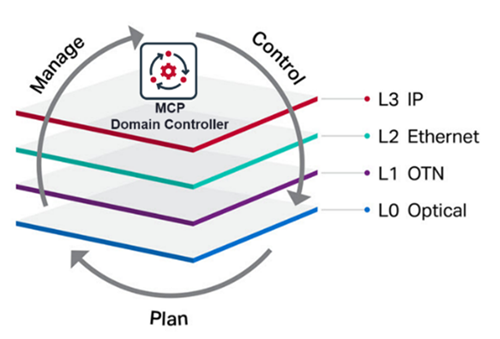The frosting on the multi-layered cake – an awesome consumer experience!
Multi-layer networks are a good thing. Decades of engineering and innovation evolved layer-specific protocols to improve communications speed, resiliency, and reach. There are various network devices, interfacing with these different protocols, to fulfill critical functions and support a diversity of applications – like mobile broadband, enterprise cloud, SD-WAN connectivity, and high-resolution media streaming. These applications require high-capacity connectivity at all times. So networks need to be kept up and running at all times. All this happens transparently to the end-consumer, who is simply enjoying the latest YouTube cat video… the frosting on the multi-layer cake, so to speak.
Specialized skills are required to manage each network connectivity layer from the ground up: fiber, coherent optics (Layer 0), optical transport (Layer 1), Ethernet (Layer 2), IP/MPLS/Segment Routing (Layer 3). To meet ever-higher capacity demands, high-performance fiber cables are extending from the core of the internet into metro regions and even further to “the last mile” – residences, enterprises, edge data centers, and 4G/5G radio towers.
With the advent of software-defined networking (SDN), it became possible to centralize, simplify and accelerate traditional network management at each layer and introduce automation to eliminate manual, repetitive tasks. With today’s continued technology advancements in software control and user experience (UX) design, there is an opportunity to further accelerate network operations by correlating network layers into a single-pane-of-glass visual and programmatic interface. At Ciena, our Manage, Control and Plan (MCP) domain controller provides that unified view, enabling optimized multi-layer lifecycle network operations – effectively holding the multiple network layers in place to best support over-the-top applications.

Figure 1: Ciena’s MCP domain controller unifies multi-layer lifecycle operations
With knowledge of the interworking of Dense Wavelength Division Multiplexing (DWDM), Optical Transport Network (OTN), Ethernet, and IP layers, network operators can increase service resiliency and provide a higher quality of experience for the end-consumer, while optimizing asset utilization. Not only does this drive top-line revenue, but it also positively impacts the bottom line since networks can be run smarter with reduced capital outlay. Decisions can be made about how best to engineer the network for service restoration after a failure – at the optical layer, IP layer, or both.
With knowledge of the interworking of Dense Wavelength Division Multiplexing (DWDM), Optical Transport Network (OTN), Ethernet, and IP layers, network operators can increase service resiliency and provide a higher quality of experience for the end-consumer, while optimizing asset utilization.
Determining the optical paths over which IP services are running has traditionally been a manual process, involving separate network operations groups. Ciena’s MCP includes integrated real-time analytics which derive the IP to optical traffic matrix and true Shared Risk Link Group (SRLG) values of IP links, enabling multi-layer correlation of traffic flows and protection mechanisms. When network faults do occur, alarm correlation across layers greatly speeds up troubleshooting, root cause analysis and problem resolution. When it comes to network planning, SRLG inheritance can be used to optimize traffic engineering, ensure service path diversity, and increase network resiliency. While visual tools are essential to clearly show multi-layer dependencies, open APIs take operations to the next level by enabling end-to-end automation of repeatable tasks. At Ciena, we provide this intelligent network control through our suite of MCP Applications, an encompassing toolset for complete multi-layer lifecycle operations.

Figure 2: Example multi-layer visualization of an IP service
As network operators are transforming their networks with new technologies, and leveraging the benefits of IP/Optical convergence, it is becoming all the more important to also converge network operations. In fact, in a recent Heavy Reading survey, 61% of operators define IP/Optical convergence as streamlining operations across IP and optical functions. Network operations teams are looking for a unified view of their network that is always current and accelerates troubleshooting, provisioning and planning workflows, optimizing for multi-layer dependencies. That’s the ultimate goal – to maintain a solid multi-layer network foundation to support the end-consumer applications that we so love!


